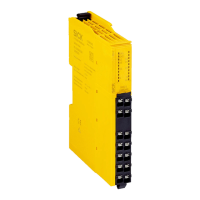1) Output circuits: These contacts must be incorporated into the control such that the
d
angerous state is brought to an end if the output circuit is open. For categories 4 and 3,
they must be incorporated on dual-channels (x, y paths). Type 2 devices are suitable for
use up to PL c. Single-channel incorporation into the control (z path) is only possible with
a single-channel control and taking the risk analysis into account.
2) To indicate the status on both sides, the MFP1 connections from the sender and receiver
must be connected to each other in the control cabinet (optional)
3) SELV/PELV safety extra-low voltage.
4.5 Testing plan
The manufacturer of the machine and the operating entity must define all required
t
horough checks. The definition must be based on the application conditions and the
risk assessment and must be documented in a traceable manner.
The following tests must be planned:
•
A thorough check must be carried out during commissioning and following modifi‐
cations.
•
The regular tests of the device must fulfill certain minimum requirements.
4.5.1 Planning the thorough check during commissioning and in certain situations
Overview
Be
fore commissioning the machine and after making changes, you must check whether
the safety functions are fulfilling their planned purpose and whether persons are being
adequately protected.
Minimum requirements
T
he device and its application must be thoroughly checked in the following situations:
•
Before commissioning
•
After changes to the configuration or the safety function
•
After changes to the mounting or the electrical installation
•
After exceptional events, such as after manipulation has been detected, after
modification of the machine, or after replacing components
The thorough check ensures the following:
•
All relevant regulations are complied with and the device is effective in all of the
machine’s operating modes.
•
The documentation accurately reflects the state/condition of the machine, includ‐
ing the protective device.
The thorough checks must be carried out by qualified safety personnel or specially
qualified and authorized personnel, and must be documented in a traceable manner.
4.5.2 Planning the regular thorough check
Overview
T
he purpose of regular tests is to identify any defects due to changes or external
influences (e.g. damage or manipulation) and to ensure that the protective measure
provides the necessary protection.
Minimum requirements
T
he following thorough checks must be carried out at regular intervals:
•
Thorough check of the housing for damage
•
Thorough check of the cables for damage
•
Check the device for signs of misuse or manipulation
•
Thorough check of the safety function
4 P
ROJECT PLANNING
14
O P E R A T I N G I N S T R U C T I O N S | ReLy OSSD1 8020860/1FH0/2022-10-27 | SICK
Subject to change without notice

